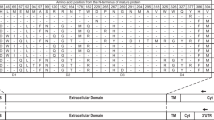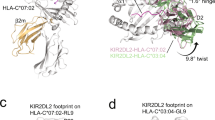Abstract
KIR2DS2 is an activating homologue of KIR2DL2, an inhibitory killer-cell immunoglobulin-like receptor (KIR) that surveys expression of major histocompatibility complex-C allotypes bearing a C1 epitope. We have studied here its allele KIR2DS2*005, which shows a hybrid structure—it is identical to other KIR2DS2 alleles in the ectodomain, but has transmembrane and cytoplasmic regions identical to those of KIR2DS3*001, a short-tailed KIR of uncertain expression and function. Our results reveal that KIR2DS2*005 is a fusion gene—the product of an unequal crossing over by which the genes KIR2DS2 and KIR2DS3 recombined within a 400 base pair region of complete identity in intron 6. Also resulting from that recombination was a shortened KIR haplotype of the B group, in which three genes commonly linked to KIR2DS2 (KIR2DL2, KIR2DL5B and KIR2DS3) are deleted. Population studies indicate that KIR2DS2*005 is still associated to such haplotype, and it can be found in approximately 1.2% of Caucasoids. Using a combination of two monoclonal antibodies, we also demonstrate that KIR2DS2*005 encodes a molecule expressed on the surface of natural killer- and T-lymphocytes.
This is a preview of subscription content, access via your institution
Access options
Subscribe to this journal
Receive 6 digital issues and online access to articles
$119.00 per year
only $19.83 per issue
Buy this article
- Purchase on Springer Link
- Instant access to full article PDF
Prices may be subject to local taxes which are calculated during checkout





Similar content being viewed by others
References
Moretta L, Moretta A . Killer immunoglobulin-like receptors. Curr Opin Immunol 2004; 16: 626–633.
Wilson MJ, Torkar M, Haude A, Milne S, Jones T, Sheer D et al. Plasticity in the organization and sequences of human KIR/ILT gene families. Proc Natl Acad Sci USA 2000; 97: 4778–4783.
Marsh SG, Parham P, Dupont B, Geraghty DE, Trowsdale J, Middleton D et al. Killer-cell immunoglobulin-like receptor (KIR) nomenclature report, 2002. Tissue Antigens 2003; 62: 79–86.
Vilches C, Parham P . KIR: diverse, rapidly evolving receptors of innate and adaptive immunity. Annu Rev Immunol 2002; 20: 217–251.
Abi-Rached L, Moesta AK, Rajalingam R, Guethlein LA, Parham P . Human-specific evolution and adaptation led to major qualitative differences in the variable receptors of human and chimpanzee natural killer cells. PLoS Genet 2010; 6: e1001192.
Pyo CW, Guethlein LA, Vu Q, Wang R, Abi-Rached L, Norman PJ et al. Different patterns of evolution in the centromeric and telomeric regions of group A and B haplotypes of the human killer cell Ig-like receptor locus. PLoS One 2010; 5: e15115.
Moesta AK, Graef T, Abi-Rached L, Older Aguilar AM, Guethlein LA, Parham P . Humans differ from other hominids in lacking an activating NK cell receptor that recognizes the C1 epitope of MHC class I. J Immunol 2010; 185: 4233–4237.
Robinson J, Mistry K, McWilliam H, Lopez R, Marsh SG . IPD—the Immuno Polymorphism Database. Nucleic Acids Res 2009; 38: D863–D869.
Rajalingam R, Gardiner CM, Canavez F, Vilches C, Parham P . Identification of seventeen novel KIR variants: fourteen of them from two non-Caucasian donors. Tissue Antigens 2001; 57: 22–31.
VandenBussche CJ, Mulrooney TJ, Frazier WR, Dakshanamurthy S, Hurley CK . Dramatically reduced surface expression of NK cell receptor KIR2DS3 is attributed to multiple residues throughout the molecule. Genes Immun 2009; 10: 162–173.
Ordóñez D, Meenagh A, Gómez-Lozano N, Castaño J, Middleton D, Vilches C . Duplication, mutation and recombination of the human orphan gene KIR2DS3 contribute to the diversity of KIR haplotypes. Genes Immun 2008; 9: 431–437.
Gourraud PA, Meenagh A, Cambon-Thomsen A, Middleton D . Linkage disequilibrium organization of the human KIR superlocus: implications for KIR data analyses. Immunogenetics 2010; 62: 729–740.
Pende D, Marcenaro S, Falco M, Martini S, Bernardo ME, Montagna D et al. Anti-leukemia activity of alloreactive NK cells in KIR ligand-mismatched haploidentical HSCT for pediatric patients: evaluation of the functional role of activating KIR and redefinition of inhibitory KIR specificity. Blood 2009; 113: 3119–3129.
Gómez-Lozano N, de Pablo R, Puente S, Vilches C . Recognition of HLA-G by the NK cell receptor KIR2DL4 is not essential for human reproduction. Eur J Immunol 2003; 33: 639–644.
Gómez-Lozano N, Estefanía E, Williams F, Halfpenny I, Middleton D, Solís R et al. The silent KIR3DP1 gene (CD158c) is transcribed and might encode a secreted receptor in a minority of humans, in whom the KIR3DP1, KIR2DL4 and KIR3DL1/KIR3DS1 genes are duplicated. Eur J Immunol 2005; 35: 16–24.
Abi-Rached L, Parham P . Natural selection drives recurrent formation of activating killer cell immunoglobulin-like receptor and Ly49 from inhibitory homologues. J Exp Med 2005; 201: 1319–1332.
Vilches C, Pando MJ, Rajalingam R, Gardiner CM, Parham P . Discovery of two novel variants of KIR2DS5 reveals this gene to be a common component of human KIR ‘B’ haplotypes. Tissue Antigens 2000; 56: 453–456.
Della Chiesa M, Romeo E, Falco M, Balsamo M, Augugliaro R, Moretta L et al. Evidence that the KIR2DS5 gene codes for a surface receptor triggering natural killer cell function. Eur J Immunol 2008; 38: 2284–2289.
Vilches C, Castaño J, Gómez-Lozano N, Estefanía E . Facilitation of KIR genotyping by a PCR-SSP method that amplifies short DNA fragments. Tissue Antigens 2007; 70: 415–422.
Gómez-Lozano N, Trompeter HI, de Pablo R, Estefanía E, Uhrberg M, Vilches C . Epigenetic silencing of potentially functional KIR2DL5 alleles: implications for the acquisition of KIR repertoires by NK cells. Eur J Immunol 2007; 37: 1954–1965.
Acknowledgements
This work was supported by grants BFU2005–04622 and SAF2010-22153-C03-03, from the Spanish Ministerio de Ciencia e Innovación. We thank María Cañizares for excellent technical assistance.
Author information
Authors and Affiliations
Corresponding author
Ethics declarations
Competing interests
The authors declare no conflict of interest.
Rights and permissions
About this article
Cite this article
Ordóñez, D., Gómez-Lozano, N., Rosales, L. et al. Molecular characterisation of KIR2DS2*005, a fusion gene associated with a shortened KIR haplotype. Genes Immun 12, 544–551 (2011). https://doi.org/10.1038/gene.2011.35
Received:
Revised:
Accepted:
Published:
Issue Date:
DOI: https://doi.org/10.1038/gene.2011.35
Keywords
This article is cited by
-
Comparative genetics of KIR haplotype diversity in humans and rhesus macaques: the balancing act
Immunogenetics (2022)
-
Revealing complete complex KIR haplotypes phased by long-read sequencing technology
Genes & Immunity (2017)
-
Recombinant structures expand and contract inter and intragenic diversification at the KIR locus
BMC Genomics (2013)



